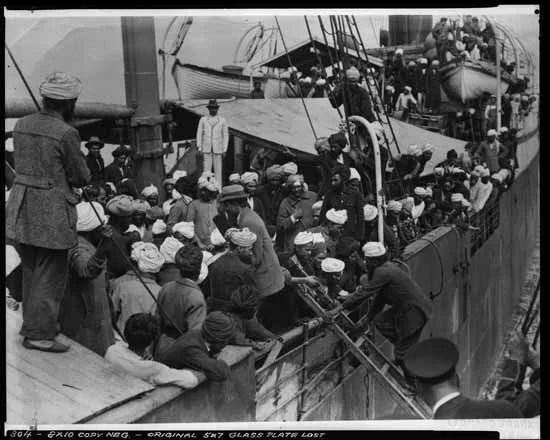Working the Green Chain: Sikhs, Fraser Mills & the Lumber Industry
There is a photograph in the Vancouver Public Library archives of a group of men, dressed in distressed overalls, their hair neatly covered by turbans, standing firm and straight, looking right into the camera. These 12 men worked at Barnet Mills. They, like many other Indian sawmill workers in British Columbia, helped drive the success of the province’s lumber industry. While the benefits of those early sawmills are still seen today, many of these men have faded into history. Our new exhibit, “Working the Green Chain: Sikhs, Fraser Mills and the Lumber Industry,” hopes to give them a face and voice once again, so we can learn and preserve their stories.
SIKH SAWMILL WORKERS. VANCOUVER PUBLIC LIBRARY 7641
Recounting the experience of their grandfathers and fathers, we talked to six community members. We learned about their journey from India to Canada, the grueling working and living conditions, the racial discrimination they faced, and how, in the midst of it all, they established a community, held firm to their faith and culture, and achieved generational success.
CROWDED DECK OF THE KOMAGATA MARU, 1914. VANCOUVER PUBLIC ARCHIVES 6232
One community member, Mike Ghuman, shared the story of how three generations of his family worked at Fraser Mills. His grandfather, Daya Singh Ghuman came to Canada in the early 1900s. While his wife did not join him, his three sons, Thakur, Avtar, and Rattan did in 1926. Rattan, Mike’s father, who came at the age of 14, studied at Millside School and worked at Fraser Mills. Eventually marrying, he had three sons of his own, Mike, Santokh and, Harminder. The older two followed in their father’s footsteps and worked at Fraser Mills, eventually moving on to work at Canada Post like their younger brother.
WORKERS AT FRASER MILLS. SURREY ARCHIVES 121.087
This July, visit the exhibit on display at the Coquitlam City Centre Library to learn more about Mike’s story and see the photographs and objects from many others. Together we can preserve the many different narratives that shaped our province’s history.





